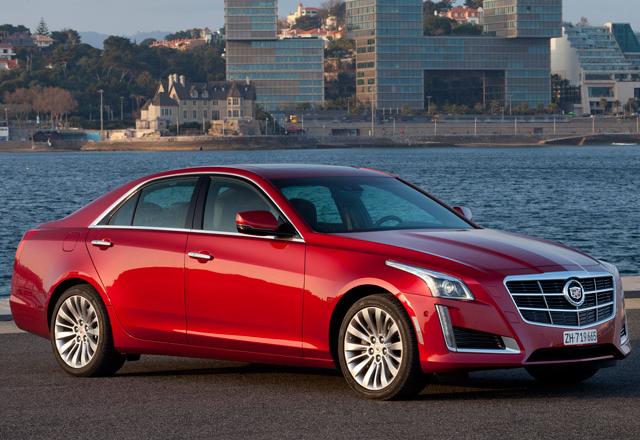You are here
Cadillac CTS 2.0L Turbo: American approach to the premium executive saloon
By Ghaith Madadha - May 29,2017 - Last updated at May 29,2017

Photo courtesy of Cadillac
General Motors third and best attempt yet to crack the German-dominated premium executive saloon segment, the third generation Cadillac CTS is larger, lighter and more sophisticated car than the one it replaces. First arriving as a 2014 model year and very mildly updated for 2017, since driven, the current CTS is crucially offered for the first time with a downsized but effective entry-level 2-litre turbocharged four-cylinder engine necessary to try to compete with the Audi A6, Mercedes-Benz E-Class and BMW executive car troika in high tax markets like Jordan.
Complex and contemporary
Closer in size, design and price to the now discontinued and more upscale STS model line than its own predecessors, the current CTS features a similar emphasis on width, with a broad, snouty and well-framed grille topped by a ridge bonnet and flanked by slim wrapover headlights positioned further to the side and lower. And like the STS, it features a long bonnet with short overhang in front contrasted with a short boot with long overhang at the rear for a more indulgent and luxurious road stance.
A more complex, evocative and better integrated evolution of Cadillac’s sharp angled and contemporary ‘art and science’ design language, the current CTS is a considerably more nuanced and mature interpretation. More layered and with more ridges, angles and surfacing definition, the new CTS flanks are notable more fluent.
A rising ridge running through the door handles adds movement, and makes its waistline seem lower than its predecessor’s almost featureless flanks. Updates include new grille and wheel designs and revised lower rear bumper with vertical exhaust openings to reflect the CTS vertical light cluster themes.
Flexible four-pot engine
Unchanged under the bonnet for 2017, the entry-level CTS is powered by an turbocharged direct injection 2-litre 4-cylinder engine with equal bore diameter and stroke length. Dense in power developed compared to displacement, the CTS 4-pot engine produces 268BHP at 5600rpm and 295lb/ft throughout a broad 3000-4500rpm peak torque band, 90 per cent of which is available during a wider 2100-5400rpm range.
Driving the rear wheels through a standard 8-speed automatic gearbox, this allows the 1651kg CTS to accelerate through the 0-100km/h benchmark in 6.6-seconds and onto a 240km/h maximum.
Responsive and quick-spooling with only slight turbo lag from idle, the CTS’ broad torque-rich rev range allows for confident on the move acceleration and flexibility. Underwritten by generous torque, the CTS develops maximum power at a relatively low revving but accessible 5600rpm. However, more peaky delivery nearer to its 6400rpm rev limit would have been more rewarding. Smooth operating in mid-range, the CTS is happy to rev high but isn’t at its smoothest as the tachometer needle reaches for the red line. Meanwhile, good fuel efficiency and a large fuel tank provide good driving range.
Balanced and settled
Driving the rear wheels through an 8-speed automatic gearbox, the CTS 2.0L Turbo’s numerous rations allow for a combination of responsive low-end acceleration, mid-range versatility and efficient and refined motorway cruising. Developed in-house by GM, the CTS’ 8-speed does a fine job and features adjustable auto and manual driving modes. However, it didn’t seem quite as slick, quick or seamlessly shifting as ZF-sourced 8-speed auto gearboxes.
Meanwhile, the CTS front-engine and rear-drive coupled with short front and long rear overhangs provide near perfect 50:50 weight distribution and agile balance through corners.
Balanced and predictable through corners, the CTS’s relatively long wheelbase means that grip levels are good, and when at the limit, rear slippage is progressive with stability controls switch off. Meanwhile its weight distribution and quick steering ratio make it eager, direct and tidy turning in, if not layered with road feel. With its balance, the CTS is rewarding in, through and out of corners, especially when driven a lower gear is selected to ensure smooth, responsive and progressive throttle control as one comes back on power when exiting.
Comfortable cruiser
Though capable and confident in terms of handling, the most abiding impression of the CTS is its stable, settled and seemingly heavy on the ground ride quality. Reassuring and indulgent on the motorway and cruising through the city, the CTS planted ride quality is almost Germanic in character, with good vertical pitch and rebound control. Comfortable over imperfections and with good body control through corners, the CTS can be slightly stiff over sudden and jagged bumps and cracks owing to its low profile tyres. However, optional adaptive magnetic dampers provide improved ride suppleness and better body lean control.
Comfortable and ergonomic in front, the CTS cabin features low-mounted and well-adjustable seats and steering, with controls within easy rear and good front visibility, while rear visibility is aided by a rearview camera. Rear seat space is fine, while boot space is adequate, if not segment leading. Luxurious with good materials, leathers and soft textures in prominent places, the CTS layout is somewhat busy with buttons and various instrument cluster light colours. Well-equipped with numerous standard and optional comfort, convenience and safety equipment, the CTS capable and advanced CUE infotainment system requires a few minutes for familiarisation, but has also been updated for 2017.
TECHNICAL SPECIFICATIONS
Engine: 2-litre, turbocharged in-line 4-cylinders
Bore x Stroke: 86 x 86mm
Compression ratio: 9.5:1
Valve-train: 16-valve, DOHC, variable valve timing, direct injection
Gearbox: 8-speed automatic, rear-wheel-drive
Gear ratios: 1st 4.62 2nd 3.04 3rd 2.07 4th 1.66 5th 1.26 6th 1.0 7th 0.85 8th 0.66
Reverse/final drive ratios: 3.93/3.85
Power, BHP (PS) [kW]: 268 (272) [200] @5600rpm
Specific power: 134.1BHP/litre
Power-to-weight: 162.3BHP/tonne
Torque lb/ft (Nm): 295 (400) @3000-4500rpm
Specific torque: 200.2Nm/litre
Torque-to-weight: 242.2Nm/tonne
Rev limit: 6400rpm
0-100km/h: 6.6-seconds
Top speed: 240km/h
Fuel consumption, city/highway: 11.2/7.6-litres/100km
Fuel capacity: 72-litres
Length: 4966mm
Width: 1833mm
Height: 1454mm
Wheelbase: 2910mm
Track, F/R: 1560/1567mm
Unladen weight: 1651kg
Weight distribution, F/R: 50 per cent/50 per cent
Headroom, F/R: 995/952mm
Legroom, F/R: 1081/899mm
Shoulder room, F/R: 1446/1392mm
Hip room, F/R: 1366/1353mm
Cargo volume: 388-litres
Steering: Variable electric-assist rack & pinion
Turning circle: 11.3-metres
Lock-to-lock: 2.6-turns
Suspension F/R: MacPherson struts/multi-link
Brake discs, F/R: Ventilated 321mm/315mm
Brake callipers, F/R: 4-/1-pistons
Tyres: 245/40R18















